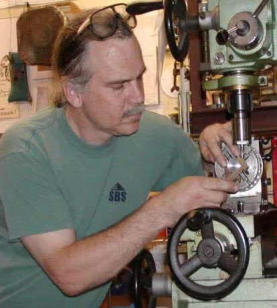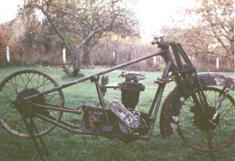
british anzani archive:
© British Anzani Archive





The BAA Meets Harry Doughty
The man who found
the rotting hulk of one
of the rarest Anzani
powered motorcycles
in the world, in a
chicken shed.
Harry, his wife Tina
and two boys Chris
and Alex live in Ladner
just outside
Vancouver.
He graduated from the
British Columbia
Institute of Technology
with a diploma in
Mechanical Design
and he is part owner
of a small engineering firm specialising in electrical drive systems for large
materials handling equipment.
Harry loves the great outdoors; hiking, gardening and fishing but has, he says,
the perfect pastime for those long Canadian winters - restoring vintage
motorcycles.
Harry, tell us about
the bike. What is it?
Well, it's a 1927 OEC-Temple
with a 500cc Anzani single.
The bike was purchased new
in Britain in 1929. A Mr. Francis
Morse bought it from Temple's
showroom in London but it was
a 1927 model. He actually took
delivery of it at the OEC
factory in Gosport and rode it to the docks for packing and export. It was
received in Victoria by Brooklands Motorcycles and the proprietor, Mr. Reg
Shanks assembled it and put it in service for him. Motor Vehicle records show it
went through a number of owners but there is no record of it being licensed for
road use after 1934.
The late Reg Shanks, proprietor of Brooklands Motorcycles in Victoria for many
years remembered the machine well when I had the good fortune to talk to him
on the subject. Both Mr Morse and Mr Shanks vividly recalled the horrible
handling of the bike. It had a terrible reputation for throwing riders off when it
went into a 'tank slapper' (speed wobble) at speeds in excess of 70 mph. This is
totally inconsistent with the reputation of the OEC as they were one of the early
pioneers of triangulated chassis designs. The makers also advertised that they
used taper roller bearings in the steering head but when I disassembled the
forks I found some unusual thrust bearings in place of the advertised taper
rollers. This would explain handling problems but I guess I will never know if
they were factory fitted or added later by a misinformed owner. One speculation
is that the factory may have run out of the correct bearings and made up some
substitutes in their own shop.
How did you find it?
As a kid growing up in Courtenay about 140 miles to the north of Victoria, we
were to told of the remains of an old bike behind a gas (petrol) station just out of
town in the village of Royston. My father was interested in vintage bikes but
couldn't be encouraged to investigate, later as a teenager, a kid in my high
school acquired it but it was far too rough a project for a kid his age. The
interesting thing is that he incorrectly identified it as a 1932 Ariel. Several years
later when I moved to Vancouver, I met the owner of a local motorcycle shop
who was restoring a 1932 Ariel and I offered to see if I could track down this
bike for him for parts. I looked up my old friend arid found the bike was still
stored in boxes in his chicken house and purchased the whole lot for $20.00!! I
immediately suspected that it was not an Ariel which my friend confirmed so I
got interested in it and decided to make it a project. It took quite a while to figure
out exactly what it was and to track down the history. The engine remained a
mystery for the longest time, eventually by eliminating the other possibilities, I
deduced that it must be BA or Vulpine. Since then I have collected all the BA
data I could and you can imagine my surprise when I stumbled on your website.
When was all this by the way?
1977. I have been working on it on and off for 25 years but I have taken some








